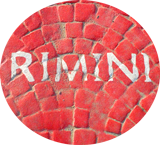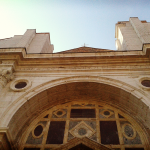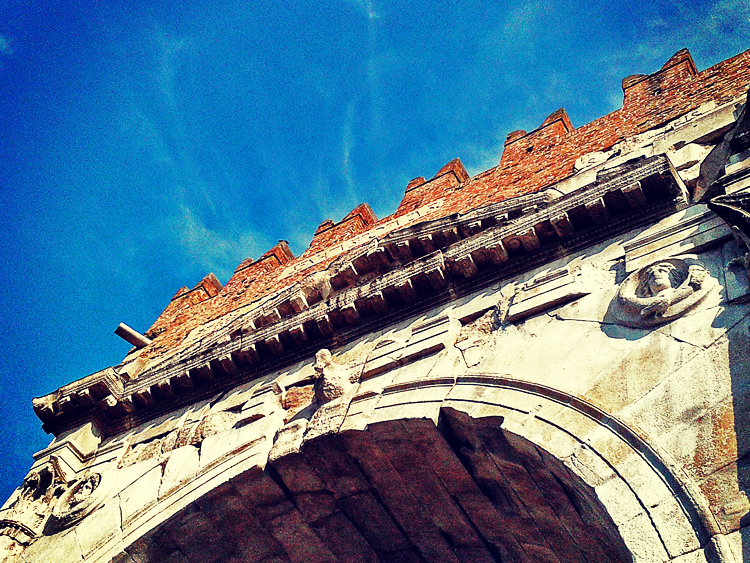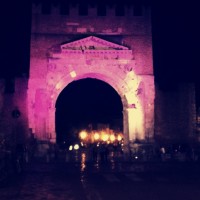Palazzo del Podestá
Many cities in Italy have a Palazzo del Podestá in a central location, and Rimini is no exception – with its impressive Palazzo Podestá one of three Palazzi dominating Piazza Cavour. Palazzo del Podestá is the smallest of the three, and is the furthest from the Corso d’Augusto. The term Podestá was used throughout the middle ages for a position similar (though not by any means identical) to that of a Mayor. Podestá, put bluntly, means power – and during the medieval period as the Italian comunes formed, the Podestá was in charge of local administration.
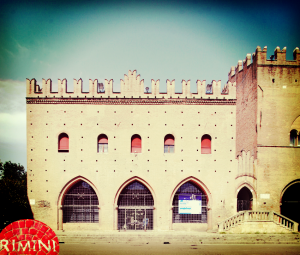
The first Podestá were appointed by the Holy Roman Emporor Frederick Barbarossa when he marched through Northern Italy asserting his power. The Podestá were appointed as his direct representatives in cities across Northern Italy, with powers, for example, to raise taxes for the Emporor. Between 1158 and 1183, though, Barbarossa faced dissent (stirred by Popes Adrian IV and his succesor Alexander III), with battles being fought and lost against the Lombard League. One of the big upshots of this was a change in the way the position of Podestá was appointed. Rather than being directly appointed by the Emporor, instead – after the peace of Constance (Konstanz) in 1183 – cities were allowed to elect their own administrative councils and Podestá, with the freedom to enact their own legislation.
Common practice was for cities to elect an outsider – from another city – as Podestá for a limited period of office, thus avoiding favouritism in the administration of local power. Some historian have likened the position to that of a modern day C.E.O. elected based on his CV, and richly rewarded for achieving good results for the comune.
Rimini had its own Podestá elected from as early as 1204. We know this because it’s the date when the oldest building in Piazza Cavour, the Palazzo dell’Arengo was built, by the then Podestá Mario de Carbonesi (originally from Bologna), as the comunal headquarters. Confusingly, perhaps, the actual Palazzo del Podestá which flanks the Palazzo Arengo was built more than a century later, in 1330. It’s perhaps an indication of the growth of the position of the Podestá in Italian administrative culture, as cities across the North of Italy established actual Palazzi for their prized administrators (many Podestá were apparently confined to their Palazzo for the duration of their office – ensuring no interference or bias could occur through mixing with the plebs). In the documentation of the time the Palazzo was refered to as the Palatium Novum, to distinguish it from the Older Palazzo dell’Arengo
The building is one of Rimini’s finest examples of gothic architecture – although (like it’s neighbouring building the Plazzo dell’Arengo) the Palazzo has been rebuilt and restored a number of times. In the 1600s for example the building was extensively rebuilt, losing much of its charm. The modern day building, was lovingly recreated in the style of the original gothic building, after the disastrous earthquake of 1916 destroyed most of Piazza Cavour. In may of that year a serious earthquake hit the area comprising Rimini and Riccione (recent research has suggested that their was an accompanying Tsunami at the time). The earthquake levelled much of Rimini, leaving four people dead and up to 60 injured. The damage was compounded by aftershocks which continued throughout the year up until December.
In the reconstruction phase, architect Gaspare Rastelli, working off documents and illustrations that described the original building, rebuilt the Palazzo close to its original gothic design. On the ground floor there are three imposing arches (recreations of ones that were once on the other side of the building, where the original facade was). On a grisly note, criminals were hung by the city authorities under the middle arch.
The Palazzo del Podestá nowadays plays host to various exhibitions held by the comune, with an excellent exhibition space and function rooms. There’s nearly always something on, and the building is well worth a visit.
